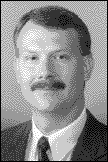 From the Executive Director
From the Executive Director
Windshield time
One thing that I have missed after leaving private practice has been the windshield time spent driving from one farm to another. Depending how stretched I was for time, these moments might have been spent on the phone, dictating notes into a recorder, eating lunch, or simply thinking about the last call or the next. Most of my travel these days is by plane. Hours on airplanes just do not match up to the quality time I used to spend behind the wheel of my practice vehicle. That window on the plane is more of a porthole than a windshield, and I never traveled from farm to farm with a large group of strangers sitting shoulder to shoulder munching on pretzels.
My recent trip driving to and from Orlando for the 2003 Annual Meeting gave me a chance for plenty of windshield time. The trip down was filled with last-minute thoughts as well as last-minute phone calls focused on the preparation for the meeting. However, the trip back was more relaxed and allowed more time to simply enjoy the road and observe the other travelers driving down the interstate. I could not help but start thinking about the road that we in the swine industry are traveling down. Several analogies popped into my mind.
The interstate is filled with all sorts of drivers and vehicles. The swine industry is similarly filled with all sorts of producers and veterinarians. On the interstate you see the big semi trucks rolling along, sometimes in long lines traveling together at high speed. Perhaps these are comparable to the large production systems, rolling along with a clear destination in mind and certain knowledge on how to get there. Some perceive them as a threat to run down anybody who gets in their way. Others perceive them as a great vehicle to lead the convoy because they deflect the wind and allow you to ride in their draft, easing the way.
You also see those drivers traveling in older, high-mileage vehicles that are still on the road because they have been cared for and well-maintained over the years. These vehicles may not be as efficient as newer models, but they are paid for and still running. They are, however, threatened by higher operational costs like maintenance and fuel. Sound like any production systems you know? There are some very skilled pork producers doing a great job with facilities that may be marginally old, but are still producing a quality product in a cost-effective manner.
There are those vehicles that run right up on your tail, with drivers urging you to either speed up or get out of the way. They are not unlike a number of swine veterinarians in today’s industry, perhaps seen as impatient and impertinent, but more likely they are visionaries with a driving sense of urgency and a keen sense of direction. They are anxious to get to the future, but are also willing to lead others down the same highway.
You have also seen those drivers who are uncertain about where they are and where they are going. Their driving reflects their uncertainty as they anxiously look for some familiar landmark or a directional sign. They may be looking for the next exit so they can ask directions. They may even be looking for an alternate route to avoid the speed and congestion on the interstate. Today’s producers face a great deal of uncertainty. Some may be looking for the exit to do just that, exit the industry. Others are seeking your advice on how to survive. There are also those looking for different ways to raise pigs, such as organic production.
Of course you cannot forget the highway patrol and county sheriffs out there picking up speeders and assisting with accidents. The swine industry has their own version of cops, namely the Food and Drug Administration, the US Department of Agriculture, the Environmental Protection Agency, and other state and local governmental agencies. How we view these agencies may be determined by our compliance to the rules of the road and our need for help.
Finally, there are those roadblocks that we know can happen at any time. For the swine industry, these could be characterized as foreign animal disease, loss of useful antibiotics, or the emergence of new diseases. We can try to steer around some, but others will have to be removed before we can continue on our way. Preparedness is essential so that our reaction to roadblocks is quick and decisive.
Right now the road we call the swine industry is wide enough for many producers and veterinarians. It is what is down the road, over the horizon, which always raises some concern. The consequences of a narrowed road will mean that some vehicles will be sitting on the side of the road. Our role as veterinarians is to ensure that our clients are given every chance to stay on the road, in the industry. Are we correctly interpreting the signs along the way? Are we adjusting speed and changing lanes as conditions change? Are we being responsible in our professional conduct? Are we even traveling to the same destination as our producers? I can think of a lot more questions that we may or may not be able to answer or may not want to even consider. Perhaps too much windshield time is a dangerous thing.
–Tom Burkgren